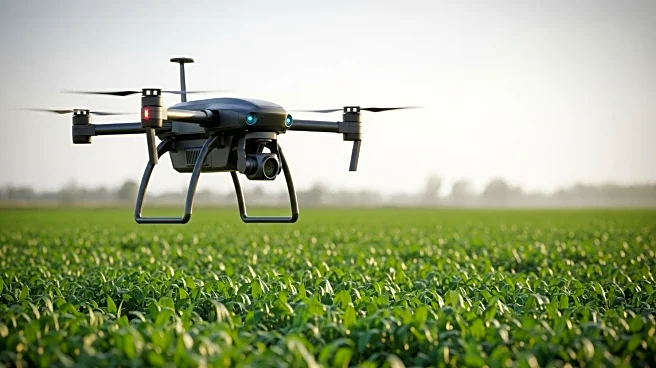What's Happening?
Artificial Intelligence (AI) is poised to revolutionize agriculture as part of the fourth industrial revolution, promising significant changes in rural life. Historical data shows that previous industrial revolutions have dramatically altered rural communities, and AI is expected to do the same, albeit at a faster pace. AI projects suggest potential increases in agricultural crop yields by 15-20% annually, which could lead to both positive and negative outcomes. On the positive side, AI could improve the rural labor market, create skilled jobs, and enhance environmental sustainability through regenerative agriculture. Conversely, negative scenarios include the potential for rural communities to diminish due to reduced labor markets, increased monoculture farming, and environmental degradation. The integration of AI in agriculture is not just about efficiency but represents a socio-economic transformation that could reshape rural communities.
Why It's Important?
The integration of AI into agriculture holds significant implications for the U.S. economy and rural communities. On one hand, AI could lead to increased agricultural productivity and sustainability, potentially boosting the agricultural GDP of low- and middle-income countries by 27%. This could create an economic effect of $250 billion in the global food production industry. On the other hand, the shift towards AI-driven agriculture could result in job displacement and a loss of traditional farming skills, impacting rural livelihoods and cultural heritage. The balance of power may shift towards large corporations, reducing diversity in agricultural practices and products. Policymakers and stakeholders must navigate these changes carefully to ensure equitable benefits and mitigate negative impacts.
What's Next?
The future of AI in agriculture will depend heavily on political actions and regulations. Policymakers are tasked with balancing the interests of farmers and AI developers to ensure fair and beneficial outcomes. The U.S. Artificial Intelligence Institute has published recommendations for AI implementation in rural communities, emphasizing needs assessment, pilot projects, community engagement, and scaling successful initiatives. Meanwhile, the Australian government has launched the AI Assurance Framework to test the safety and impact of AI applications. As different countries adopt varied approaches, the effectiveness of these strategies remains to be seen. Rural voters' engagement with political processes will be crucial in shaping the future of AI integration in agriculture.
Beyond the Headlines
The introduction of AI in agriculture could lead to deeper societal changes, including shifts in self-identification and social ties within rural communities. The concept of 'digital agriculture infection' highlights potential losses in farmers' connection to the land and the pleasure derived from traditional farming practices. As AI becomes more prevalent, rural residents may experience a sense of being controlled by external forces, leading to decreased motivation and competence. These cultural and psychological impacts could trigger resistance similar to historical uprisings against technological advancements. However, AI also offers opportunities for improved education, healthcare, and public services in rural areas, potentially bridging the gap between urban and rural living standards.












